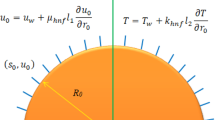Abstract
Experimental and numerical investigations on the mixing quality of a novel micromixer are conducted. A micromixer made by PDMS is fabricated to evaluate the mixing process in comparison with the numerical simulations. The main purpose of the present paper is to propose an efficient divergence–convergence based macromixer for low-Reynolds-number flows. The effect of inlet velocity (Reynolds number), number of mixing cycles and blockage ratio on the mixing performance of the micromixer is investigated. The results reveal that the mixing efficiency (ME) increases with injection velocity, number of cycles and blockage ratio. For the range of Reynolds number from 9 to 75, the Dean vortices are not formed, however, generation of expansion vortices is the main factor of mixing for Re > 19. It is demonstrated that the value of ME/ΔP (Pa−1) for the micromixer with three, four, five and six mixing cycles is 6.36, 2.23, 0.74, and 0.5, respectively. In addition, the micromixer with the blockage ratio of 0.25 reaches the mixing efficiency of 100%. Relatively high values of ME/ΔP makes the proposed micromixer suitable for practical applications in which the Reynolds number is less than 75.
















Similar content being viewed by others
References
Nguyen N-T, Wu Z (2005) Micromixers—a review. J Micromech Microeng 15:R1–R16
Afzal A, Kim K-Y (2014) Three-objective optimization of a staggered herringbone micromixer. Sens Actuat B Chem 192:350–360
Chung CK, Shih TR (2007) A rhombic micromixer with asymmetrical flow for enhancing mixing. J Micromech Microeng 17(12):2495–2504
Tan H (2019) Numerical study of a bubble driven micromixer based on thermal inkjet technology. Phys Fluid 31:062006
Lin Y, Gao C, Gao Y, Wu M, Ahmadian Yazdi A, Xu J (2019) Acoustofluidic micromixer on lab-on-a-foil devices. Sens Actuat B Chem 287:312–319
Usefian A, Bayareh M, Shateri A, Taheri N (2019) Numerical study of electro-osmotic micro-mixing of Newtonian and non-Newtonian fluids. J Braz Soc Mech Sci Eng 41(5):238
Usefian A, Bayareh M (2019) Numerical and experimental study on mixing performance of a novel electro-osmotic micro-mixer. Meccanica 54(8):1149–1162
Niu X, Lee Y-K (2003) Efficient spatial-temporal chaotic mixing in microchannels. J Micromech Microeng 13:454–462
Usefian A, Bayareh M, Ahmadi Nadooshan A (2019) Rapid mixing of Newtonian and non-Newtonian fluids in a three-dimensional micro-mixer using non-uniform magnetic field. J Heat Mass Transf Res 6(1):55–61
Afzal A, Kim K-Y (2014) Performance evaluation of three types of passive micromixer with convergent–divergent sinusoidal walls. J Mar Sci Technol 22(6):680–686
Izadpanah E, Hekmat MH, Azimi H, Hoseini H, Rabiee MB (2018) Numerical simulation of mixing process in T-shaped and DT-shaped micromixers. Chem Eng Commun 205(3):363–371
Cheri MS, Latifi H, Moghaddam MS, Shahraki H (2013) Simulation and experimental investigation of planar micromixers with short-mixing-length. Chem Eng J 234:247–255
Hessel V, Lowe H, Schonfeld F (2005) Micromixers—a review on passive and active mixing principles. Chem Eng Sci 60:2479–2501
Bessoth FG, de Meelo AJ, Manz A (1999) Microstructure for efficient continues flow mixing. Anal Commun 36:213–215
Löb P, Drese KS, Hessel V, Hardt S, Hofmann C, Löwe H, Werner B (2004) Steering of liquid mixing speed in interdigital micro mixers–from very fast to deliberately slow mixing. Chem Eng Technol 27(3):340–345
Hessel V, Hardt S, Löwe H, Schönfeld F (2003) Laminar mixing in different interdigital micromixers: I. Experimental characterization. AIChE J 49(3):566–577
Hardt S, Schönfeld F (2003) Laminar mixing in different interdigital micromixers: II. Numerical simulations. AIChE J 49(3):578–584
Hardt S, Dietrich T, Freitag A, Hessel V, Löwe H, Hoffman C, Oroskar A, Schönfeld F, VandenBussche K (2002) In: Rinard I, Hoch B (eds) Sixth international conference on microreaction technology, IMRET 6, vol 164. AIChE Publications, New Orleans, pp 329–344
Hong CC, Choi JW, Ahn CH (2004) A novel in-plane microfluidic mixer with modified tesla structures. Lab Chip 4:109–113
Liu RH, Stremler MA, Sharp KV, Olsen MG, Santiago JG, Adrian RJ, Aref H, Beebe DJ (2000) Passive mixing in a three-dimensional serpentine microchannel. J Microelectromech Syst 9(2):190–197
Alam A, Afzal A, Kim K-Y (2014) Mixing performance of a planar micromixer with circular obstructions in a curved microchannel. Chem Eng Res Des 92(3):423–434
Chen X, Zhang S, Wu Z, Zheng Y (2019) A novel Koch fractal micromixer with rounding corners structure. Microsyst Technol 25(7):2751–2758
Hama B, Mahajan G, Fodor PS, Kaufman M, Kothapalli CR (2018) Evolution of mixing in a microfluidic reverse-staggered herringbone micromixer. Microfluid Nanofluid 22(5):22–54
Khosravi Parsa M, Hormozi F (2014) Experimental and CFD modeling of fluid mixing in sinusoidal microchannels with different phase shift between side walls. J Micromech Microeng 24(6):065018
Mondal B, Mehta SK, Patowari PK, Pati S (2018) Numerical study of mixing in wavy micromixers: comparison between raccoon and serpentine mixer. Chem Eng Process—Process Intensif 136:44–61
Bayareh M, Nazemi Ashani M, Usefian A (2020) Active and passive micromixers: a comprehensive review. Chem Eng Process-Process Intensif. 147:107771. https://doi.org/10.1016/j.cep.2019.107771
Author information
Authors and Affiliations
Corresponding author
Ethics declarations
Conflict of interest
The authors declare that they have no conflict of interest.
Additional information
Publisher's Note
Springer Nature remains neutral with regard to jurisdictional claims in published maps and institutional affiliations.
Rights and permissions
About this article
Cite this article
Usefian, A., Bayareh, M. Numerical and experimental investigation of an efficient convergent–divergent micromixer. Meccanica 55, 1025–1035 (2020). https://doi.org/10.1007/s11012-020-01142-0
Received:
Accepted:
Published:
Issue Date:
DOI: https://doi.org/10.1007/s11012-020-01142-0




